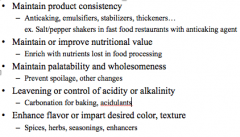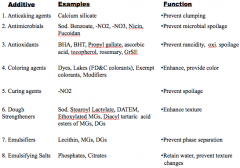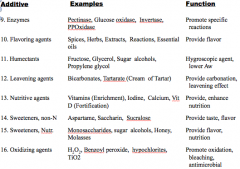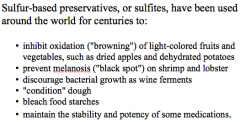![]()
![]()
![]()
Use LEFT and RIGHT arrow keys to navigate between flashcards;
Use UP and DOWN arrow keys to flip the card;
H to show hint;
A reads text to speech;
15 Cards in this Set
- Front
- Back
|
What is a food additive?
|
A substance that becomes part of a food through intentional or accidental means.
|
|
|
History of food additives
|
Salt Preservation (Ancient Egyptians, 3000BC-30BC)
Acid Pickling (Ancient Mesopotamians, 2400BC) Spice Flavoring (1000BC, cardamom, pepper, cinnamon) |
|
|
Types of Food Additives
|
Direct/Intentional
Indirect/Unintentional Adulteration |
|
|
Direct/Intentional
|
- Purposely added substances, intended to generate a specific result.
- Addition may occur at any step in the formulation, production, manufacturing, packing, processing, preparing, treating, packaging, transporting, and holding of food. - Requires FDA approval for intended use (exemptions) Ex. sugar, flavorants, colorants, texturizing agents |
|
|
Indirect/Unintentional
|
Substances (including contaminants) that accidentally get into foods during processing, production, packaging, storage…
Usually anticipated and controlled to minimize occurrence FDA – Defines minimum permissible quantities; regulated and must be met before sale Ex. Antibiotics, chemical pollutants (pesticides), dirt, hair, dust, hormones, insects, microwave packaging, animal parts, heavy metals, fungal toxins… |
|
|
Adulteration
|
- NOT an Indirect Food Additive…not indirect or direct
- Contamination that is deliberately added to food - Usually driven by economics - Illegal in US Examples: Offal tissues in ground meats Watered down sodas/ juices Sawdust in Nutmeg |
|
|
FFDCA definition of Food Additive
|
- Includes processing treatments (radiation) AND manipulation (bioengineering)
- Can develop hazards (radioactive isotopes, toxins) - Acrylamide (asparagine in potato foods) ....Indirect Food Additive or Adulterant? |
|
|
Acrylamide
|
A chemical that can form in some foods during high-temperature cooking processes, such as frying, roasting, and baking.
Forms from sugars and an amino acid (asparagine) during certain types of high-temperature cooking, such as frying, roasting, and baking.; it does not come from food packaging or the environment. Acrylamide caused cancer in animals in studies where animals were exposed to acrylamide at very high doses. Acrylamide causes nerve damage in people exposed to very high levels at work. |
|
|
Why use Food Additives?
|

Maintain product consistency
Anticaking, emulsifiers, stabilizers, thickeners… ex. Salt/pepper shakers in fast food restaurants with anticaking agent Maintain or improve nutritional valuEnrich with nutrients lost in food processing Maintain palatability and wholesomeness ex. Prevent spoilage, other changes Leavening or control of acidity or alkalinity ex. Carbonation for baking, acidulants Enhance flavor or impart desired color, texture ex. Spices, herbs, seasonings, enhancers Make food safe to store, extend shelf life, preserve ex. Control cost, convenience Remove newly discovered undesirable additives ex. Flavor enhancer to lower, remove Na in foods without flavor loss Retain original value (nutritive, sensory, texture, safety) of foods ex. Acidulants added to tomato sauce to achieve microbial control without need for pasteurization temperatures Standardize a product ex. off-season vs in-season tomato paste |
|
|
Role of Food Additives
|
Most serve to deliver a specific functionality
(color, texture, flavor, etc) Some can impart multiple functions (citric acid: acidulant, flavor, preservative, sequestrant, flavor enhancer) Some can impart desirable functionality in some situations and undesirable in others (PPO – Polyphenol oxidase – Ripening in tea, coffee, tobacco; enz. Browning/discoloration in fruits) |
|
|
Food Additives use condition
|
1. Must be used in accordance with stated function, provide positive efficacy
2. Must not significantly deteriorate nutritional value or deceive consumer in any way 3. Must be able to monitor quality by acceptable method of analysis like: - AOAC, Association of Official Analytical Chemist, Official Methods of Analysis) -Codex Alimentarius (WHO, FAO) |
|
|
Categories of Food Additives 1
|

|
|
|
Categories of Food Additives 2
|

|
|
|
Categories of Food Additives 3
|

|
|
|
Multi-functional Food Additives
|

|

